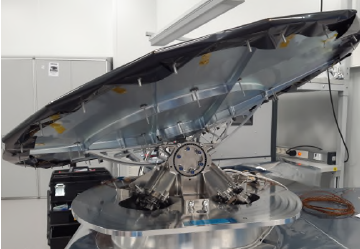Pacis 3 Mechanical Reflector Assembly on its way to a complete qualification
An innovative antenna pointing mechanism developed by Sener is currently going through the final functional test sequence that should conclude its qualification campaign for the Spainsat NG satellite in the frame of ESA’s Pacis 3 Partnership Project.
Pacis 3 is a Partnership Project (PP) between the satellite operator Hisdesat in Spain and the European Space Agency (ESA), with the support from Spain’s Centre for the Development of Industrial Technology (CDTI).
ESA Telecoms Partnership Projects develop new sustainable end-to-end systems, up to in-orbit validation. The Pacis 3 project objectives are the development and integration of innovative antennas up to in-orbit validation, such as the fully reconfigurable transmit and receive X-band active antennas, and the deployable pallet with individually steerable Ka-band antennas. These antennas are developed under the leadership of Airbus Defence and Space, Spain, as industrial prime.

The Mechanical Reflector Assembly (MRA) consists in the association of an Aluminum parabolic reflector with an Antenna Pointing Mechanism (APM). The APM will provide the required orientation of the antenna.
Six MRAs will be mounted on a deployable pallet attached to the side of the spacecraft. Working in Ka-band for both transmit and receive links, each of the six MRAs will generate a steerable spot beam that can be pointed anywhere on the surface of the Earth visible from the spacecraft.
In a highly competitive Antenna Pointing Mechanism (APM) market, Sener has developed a truly innovative solution to achieve the specified reflector pointing angles. By combining the rotational motion of two actuators with a spherical mechanism, it has been possible to minimize the size of the mechanism but also to remove the need of any Hold-on and Release Mechanism (HRM) usually required to stow the reflector until its deployment.
Completion of functional testing will be achieved in January 2022 and the subsequent Critical Design Review that will be held in February 2022 will authorise the manufacturing of the first batch of MRA to be delivered in May 2022.


